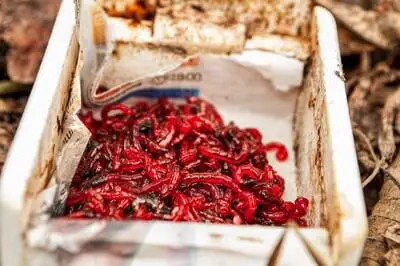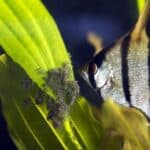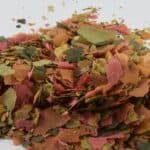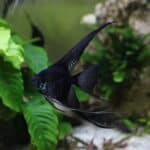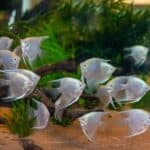Angelfish are omnivorous, meaning that they eat meat and plant matter. In the wild, angelfish feed off a selection of worms. Replicating this diet is the best way to ensure they get all the nutrients they need to stay healthy.
Angelfish like eating worms, especially bloodworms, black worms, mealworms, and tubifex worms. All provide a good source of protein and fat. However, due to their fatty content, you should only feed angelfish worms once a week to prevent weight gain. Anchor worms are inedible. They’re a parasite that buries into a fish’s skin and feeds off blood and nutrients. They’re easy to see with the naked eye.
When providing live food for angelfish, you’re allowing them to hunt and activate their minds, keeping them healthy and mentally active. Find out what types of worms angelfish eat and their health benefits.
Are Bloodworms Good For Angelfish?
Bloodworms are the larvae of non-biting mosquitoes. They’re one of the most common and popular foods in the aquatic food chain, as all meat-eating fish consume them if given a chance.
If you’re wondering, do angelfish like bloodworms? They make a tasty treat, and when fed live, they allow angelfish to hunt for their prey. This provides the mental stimulation that many angelfish lack in commercial tanks.
Bloodworms are rich in protein and iron. As described in a journal from the Department of Animal Biology, angelfish need protein to obtain amino acids to either synthesize new proteins or replace existing ones.
Without enough protein in the diet, angelfish are at risk of stunted growth and a range of other health problems.
However, bloodworms should be considered a treat as too much can cause excessive weight gain and malnourishment. They’re also tricky for angelfish to digest, particularly the head.
Not only that, but they’re not a complete source of vitamins, minerals, and amino acids, so they’re not suitable as a single source of nutrition.
Feed angelfish bloodworms once or twice a week alongside a healthy diet of pellets, flakes, and vegetables.
Do Angelfish Eat Anchor Worms?
Anchor worms (Lernaea cyprinacea) aren’t the type of worm you’d want your angelfish to eat. That’s because they’re parasites that bury into a fish’s body, feeding off the blood and nutrients.
Their heads enter the body, while the rear contains two egg sacs that remain exposed. You’ll commonly find them buried behind the angelfish’s pectoral or dorsal fin.
According to a study by Aquaculture, the lifecycle from anchor worm egg to adult took 13-14 days in temperatures between 71.5-77 F.
Once the reproduction process ends, male anchor worms die. At the same time, females remain alive and search for another host to feed off.
Anchor worms are visible to the naked eye, so they’re relatively easy to diagnose. Alongside this, other symptoms include:
- Rubbing against plants, ornaments, and the tank’s glass to dislodge the parasites
- Stress and agitation
- Loss of appetite
- Weight loss
To remove the parasite, owners must use tweezers to grip the body as close to the entry point as possible, carefully teasing it out. This process is very similar to tick removal.
However, you must be careful when doing this, as the head can get stuck in the fish if it’s not appropriately loosened. Many owners cannot do this themselves, so the fish will require treatment from a veterinarian while under sedation.
You’ll also need to treat the entire aquarium with a medication to kill the juvenile anchor worms. If they’re not dealt with, they can re-infect the fish and cause secondary bacterial infections where they wound the skin.
Your vet can recommend the best course of treatment when it removes the parasite.

Do Angelfish Eat Black Worms?
Black worms are one of the most popular amongst angelfish. They’re packed with protein and other essential nutrients, and they can survive for long periods in freshwater tanks.
This means they won’t taint the water, so they don’t need to be fished out if they’re left uneaten. Instead, you can leave them swimming around in the aquarium until your angelfish get hungry or fancy a tasty snack.
Black worms sometimes manage to avoid the fish’s clutches, burrowing into the sand at the bottom of the tank. While they’re there, they aerate the soil and keep the substrate healthy.
This is also good for an angelfish’s mental stimulation, as they’re able to entertain their hunting instincts by scouring the tank’s floor.
When angelfish get hold of black worms, they’ll hunt and attack, sucking them whole through their mouths. Black worms are good for picky fish who reject other foods, helping to provide them with the nutrients they need to prevent them from becoming underweight.
Most black worms can be dropped into the aquarium one at a time with a pair of tweezers or forceps. Feed them to your angelfish after they’ve eaten their regular food to prevent overeating or pickiness.
Can Angelfish Eat Mealworms?
Angelfish are attracted to mealworms because they’re tasty and nutritious. They’re also commonly used by fishermen as bait for the same reason.
Freshly hatched baby mealworms are best for smaller fish. Large fish are okay to eat adult mealworms. One of the things to watch out for with mealworms is the hard outer shell, which may be too tough for angelfish to digest efficiently.
Mealworms bite. They have mandibles to bite, cut, and hold food. As a result, it’s a good idea to crush the heads before feeding them to your angelfish to prevent the bite risk. Feeding dried mealworms is another way to avoid this issue.
As a result, you’ll need to watch your hands when placing them into the tank alive.
Do Angelfish Eat Tubifex Worms?
Tubifex worms are a source of debate amongst owners. Some believe they’re the best live fish food, whereas others prefer to stay away from them altogether.
Many owners don’t like tubifex worms because they can bring diseases into the aquarium. They eat anything they’re raised in, such as dirt and fish excrement.
As a result, they harbor harmful bacteria and parasites that can make angelfish sick. That said, angelfish love the taste of tubifex worms. If cleaned properly, they make an occasional tasty treat.
To ensure they’re safe for your angelfish to eat, follow these important steps:
- Only get tubifex worms from a reputable store, ensuring the water they’re kept in is clear.
- Place the worms into a large container filled with dechlorinated water, rinsing them 3-4 times a day until they run clear.
- Pop them into a refrigerator and examine the water quality each morning.
- As soon as the water is clear, they’re safe to feed to your angelfish.
Like bloodworms, tubifex are high in good-quality protein, but they’re fattening. Angelfish that feed on too many worms are at risk of rapid weight gain, obesity, and fatty liver disease.
Tubifex worms are also low in essential amino acids, causing malnourishment and deficiencies. As a result, reserve them as a bi-weekly treat to prevent overfeeding.
Do Angelfish Eat Earthworms?
Earthworms aren’t something that angelfish naturally encounter in the wild. Fishermen commonly use earthworms as bait, but as an angelfish’s habitat is in the Amazon rainforest, they wouldn’t be affected by this.
That being said, angelfish are happy to eat any worm they can hunt, so earthworms are firmly on the menu. Because of their fatty content, most fish find them tasty enough to enjoy.
However, while earthworms contain adequate levels of protein, amino acids, and lipids, they also carry pathogens that can be harmful to angelfish.
As a result, earthworms must be cleaned in the same way as tubifex worms to make them safe for your fish to eat.
Similarly, if you decide to use earthworms from your yard, you must be sure you haven’t used any harmful pesticides or chemicals on your soil, plants, and flowers.
If you have, there’s a high chance that the earthworms are contaminated and could therefore poison your angelfish.
How To Feed Angelfish Worms
Worms aren’t the most pleasant things to have in your fridge or freezer, especially if they’re still alive. As a result, some angelfish owners prefer to feed them freeze-dried.
There are pros and cons to all feeding methods, so you’ll need to decide which one you’re most comfortable with.
The thing that all methods have in common is that worms should be restricted to once or twice a week as a treat to prevent overfeeding.
These are the easiest and most popular ways to feed worms to angelfish:
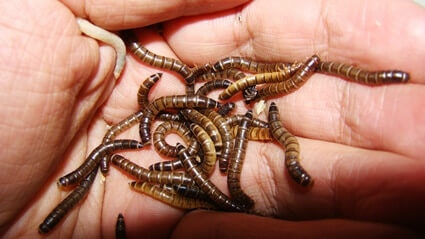
Freeze-Dried Worms
Freeze-dried worms are arguably the cleanest and most straightforward way to feed angelfish worms. They come in small plastic tubs and are usually available in grade A and grade B varieties.
Grade A is more expensive because it contains a better-quality feed. Grade B is filled with non-worm particles to bulk them out.
Freeze-drying removes some of the nutrients, making them less nutritious than frozen or live worms. However, as already mentioned, they are the easiest way to feed.
To soften the worms before feeding, soak them in water for a couple of minutes. Most angelfish feed at the water’s surface or in the tank’s mid-section, but some enjoy foraging at the bottom for food.
As a result, to give angelfish a wide choice and to provide mental stimulation, soak a couple of worms for an extra 10 minutes so that they sink to the bottom of the aquarium.
Frozen Worms
Frozen worms are another excellent option and stay fresh for up to six months, giving them an advantage over live worms.
They’re also more convenient to feed than live worms. Freezing them locks in their healthy nutrients.
Frozen worms must be thawed for around 30 seconds to one minute and drained before they’re fed to angelfish. This makes them easier to digest.
However, while frozen worms are less likely to carry parasites than live worms, they don’t offer angelfish the chance to hunt, making them less enjoyable.
Also, when feeding frozen worms, only provide what can be eaten by angelfish in three minutes. Any more than this causes contamination issues inside the tank, disrupting the aquarium’s fragile ecosystem and allowing harmful chemical levels to rise.
Live Worms
The final way to feed worms is to put them into the tank live using tweezers or forceps. When doing so, use gloves to protect your hands from bites and bacteria.
Buying them from a reputable breeder reduces the risk of harmful parasites, but you should still proceed with caution just in case the worms are infected.
When storing your worms, place them into a plastic tub or container with enough water to cover the bottom.
As already mentioned, some worm species need to be cleaned before they’re fed to angelfish. This is to remove harmful bacteria and parasites that can make fish sick.
You should rinse all live worms before adding them to the tank. Similarly, don’t add any of the water they were stored into the tank, as it could disrupt the water’s balance.
A worm’s lifespan is relatively short, so you should provide it to angelfish within 2-3 days.
Angelfish love live worms because they can hunt for them, so feeding them using this method is the best way to replicate their natural habitat.
There are many more health benefits to feeding angelfish worms than there are avoiding them. Although too many can make your fish fat, adding them to your angelfish’s diet once a week is the best way to boost their protein levels.

